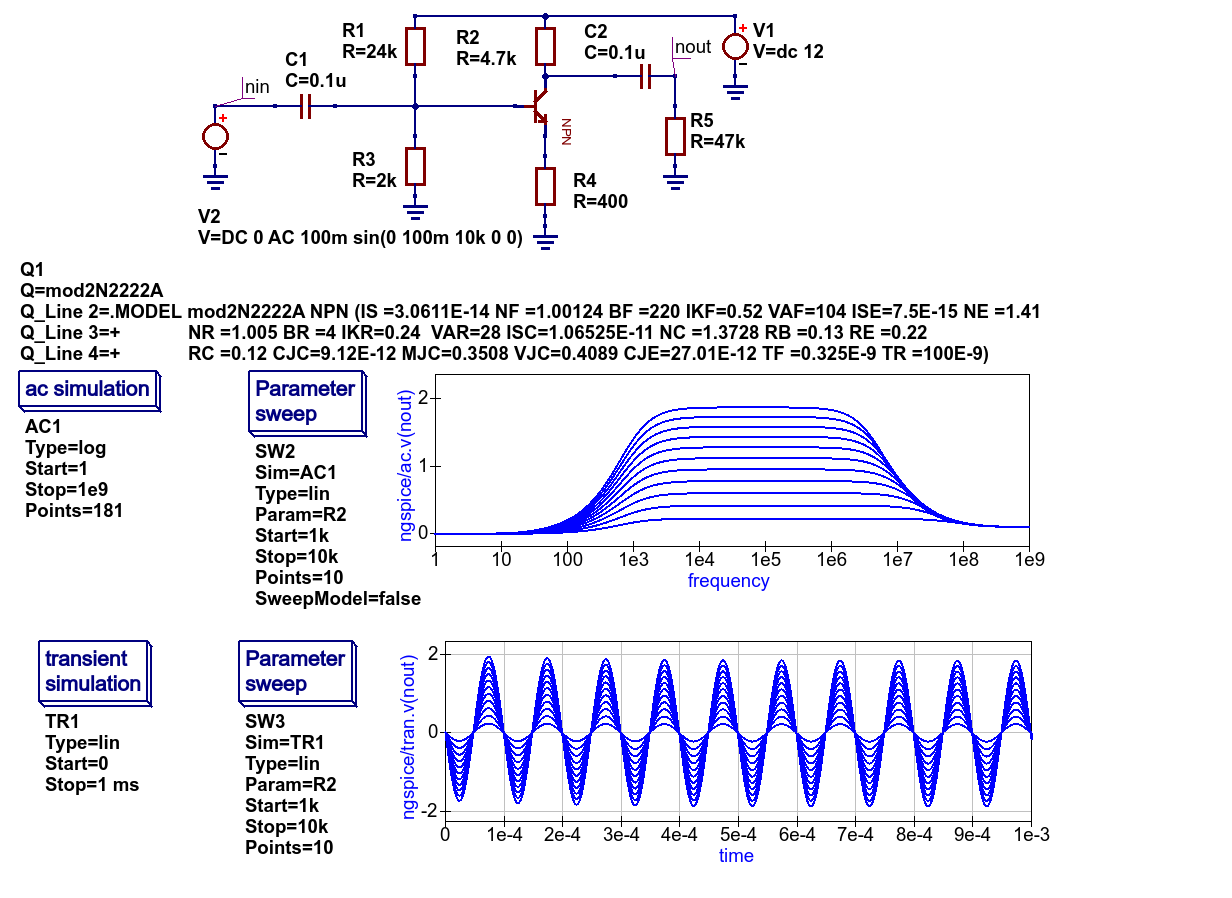
The difference is the phase of the reflected signal-an open circuit reflects without any phase change, whereas a short circuit inverts the phase. There are two easy ways to make a perfect impedance mismatch: An open circuit (infinite impedance) or a short circuit (0Ω impedance).
QUCS SIMULATION TUTORIAL FULL
And, if the impedance mismatch is 100%, then the full signal is reflected back. When a signal propagates on a transmission line and encounters an impedance mismatch, part of it is reflected back to the source because it can’t go anywhere else.
QUCS SIMULATION TUTORIAL HOW TO
You may wonder how to actually make such a signal reflector, but long-time readers will remember an article I wrote several years ago called “Time Domain Reflectometry” ( Circuit Cellar 225, April 2009). As in my example above, this adds the signal and a copy shifted by half a wavelength, and we should get zero.įIGURE 2 – A shift of half a wavelength can be made with a quarter wavelength stub, ended by a perfect reflector.

The signal will then be reflected back on the same wire, will be shifted again by l/4 on its way back, and will be merged with the original signal. Assume that there is a reflector at the end of this wire. Half of it continues to the output on the right, whereas the other half goes into a wire that introduces a l/4 delay. The signal is coming from the left, and is virtually split into two parts. Now look at Figure 2 for an easy way to do it. I’m sure you’ve followed me up to this point, right? So, you will also easily understand that, rather than delaying by l/2, we would get the same result if we delayed the signal twice-each time by l/4. What happens if we then sum the original signal and its copy delayed by l/2? Naturally, they will cancel out, and the result will be zero-a null signal. We get the same sine signal, but with an opposite phase. Now, imagine that we delay this signal by half the wavelength.
QUCS SIMULATION TUTORIAL FREE
On a wire, or more exactly on a so-called transmission line comprising the wire and the accompanying current return path, the propagation speed will be close to the speed of light in free space, c, which is 300,000,000m/s.įIGURE 1 – The sum of two sine signals cancel out if one is shifted by half a wavelength. This wavelength is the propagation speed of the signal along the wire, divided by the frequency of the signal. Such a signal has a given wavelength, usually noted as l (the Greek letter, “lambda”). Assume that you have a sine-shaped signal propagating on a wire. Let’s start with a very simple mental experiment (Figure 1). I will provide some resources for further reading, if you want to dig more deeply into the subject. Anyway, I hope that you will catch the important points. The downside is that my explanations will approximate. So, the good news is that this article should be easy to read. This may jeopardize the performance of your project, at least if you are using high frequencies or fast digital circuits.įinally, and as usual, I will not use math to convey these principles, but rather words and small experiments. I will also show you that you may inadvertently make such a filter, for example with an improper printed-circuit design. More precisely, my goal is to explain what a stub filter is, and how to build one. If you don’t know why, then keep reading because this will be my topic this month.

The wire becomes useless because one of its ends is open. If we then disconnect the wire from B, no current can flow. QucsStudio-Tutorial Part 2: Harmonic Balance Simulations Version 1.Welcome back to “The Darker Side.” As electronics designers, we all know what a wire is and how it works, right? If we connect a wire from A to B, a current can flow between these two points. Second Example: Examining this FET Amplifier Stage for a fixed Operating The Simulation Ideal an real Transfer Linear Presentation of S21 for different Input Voltage Presentation of S21 in dB (including 1 dB compression point) for differentInput voltage Rise of Harmonics for increasing Input Voltage Amplitude (linear Presentation) Rise of Harmonics for increasing Input Voltage Amolitude (presentation in dBm at 50 ) The complete Output Spectrum The IP3 Simulation of IP3 using the Transfer Simulation of IP3 using the Output Spectrum225. First Example: a FET Amplifier Stage explored by a Parameter Simulation of the Relation between Forward Transmission S21 and Supply The 1 dB Compression Point Linear Presentation of the Transfer Characteristic for different values of the Power Supply Voltage Vdd124. QucsStudio- Tutorial part 2:Harmonic Balance SimulationsVersion : Gunthard Kraus, DG8GB, Guest Professor at the Duale Hochschule Baden-Wuerttemberg (Friedrichshafen / Germany), assisted by the Programs Author Michael Margraf, DD6 UMEmail: 1st, 20161 Table of Contents. Example: dental hygienist Search QucsStudio- Tutorial Part 2 - Gunthard Kraus


 0 kommentar(er)
0 kommentar(er)
